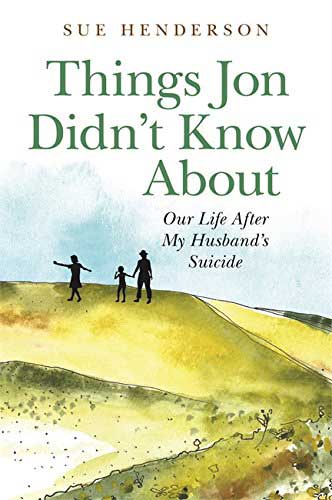
Things Jon didn’t know about: our life after my husband’s suicide
by Sue Henderson (2018) London: Jessica Kingsley Publishers. ISBN 978 1 78592 400
This is a powerful, honest and beautifully written account of one mother’s experience of life bringing up two children in the shadow of her husband, their father’s suicide. The author is a gifted writer who shares in detail the emotional and practical moments that make up daily living with her children, and no longer husband. This is not a chronological version of this family’s life. It is an eloquent chronicle covering a wide range of bereavement issues, detailing personal moments and experiences, and supportive and awkward responses and interventions of others.
While the book is very much about living without Jon, it is much more than just a book about life following suicide. It is a worthy read for many who are bereaved and for all counsellors who may support someone who grieves.
Sue Henderson was a social worker for 25 years. Her particular story focuses on what followed that eventful day, 15th August 2001. Her husband left for work as usual at 7.30 but went for a walk to Arthur’s Seat in Edinburgh – and never came back. All details relate to that moment and Henderson shares vivid details of the experiences, feelings, thoughts, children’s questions, and reactions of friends.
Each chapter carries a theme, such as “A crash course in widowed single parenting”, “Talking to the children” and “New relationships”. Each offers up reflections and understandings of how life changes for those continuing to live after the death of someone significant.
Things Jon Didn’t Know About also offers much to counsellors. Early in the narrative, the author politely suggests that theories of grief are not as meaningful as we might propose them to be; they are “fairly irrelevant in the face of reality…” though they “can inform and lend a helpful skeleton”.
The writing is forthright and direct but in a gentle way. Heartache and wonderings of what might have been, is painfully present. But Sue Henderson offers a skilful rhythm to her writing, allowing readers to swing high and low without falling. She includes an appendix detailing helpful information about services, getting help and things to do to support grieving.
The last words, before the appendix, are from her teenage daughter, who was 27 months old at the start of the book. Her essay is a powerful reminder of the resilience of youth and maturely expresses the importance of continuing bonds with a father who died by suicide.
There is a uniqueness to grief by suicide which is evocatively shared, but to pigeon hole this book into one that is only about suicide, is to lose a lot of learning for a wider audience. The author also addresses much that affects those whose grief is may not be defined by suicide.
